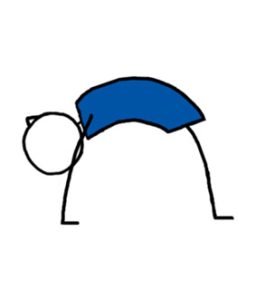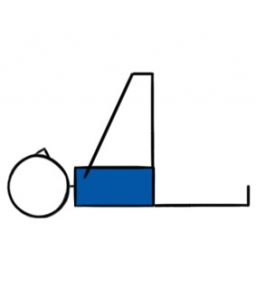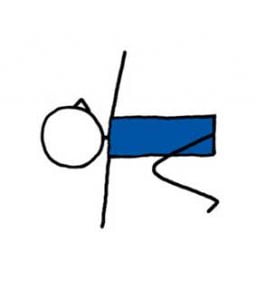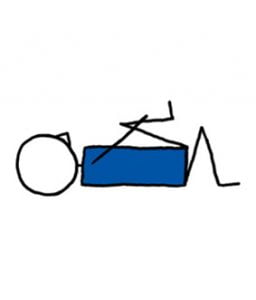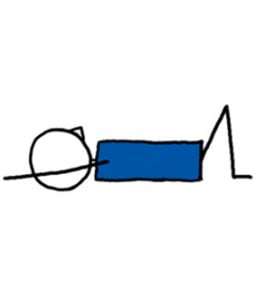
Bananasana
| Similar Pose Names: | Supine Side Bend, Supine Palm Tree,Supine Crescent Moon,Spinal Twist,Lying Down Twist |
|---|---|
| Category: | Seated & Floor |
| Share on: |
 Yoga Lesson Planner
Yoga Lesson Planner
 Pilates Lesson Planner
Pilates Lesson Planner
| Category: | Yoga Lesson Planner |
|---|---|
| Sub Category: | Seated & Floor |
| Types: | Seated & Floor, Side Bend, Stretch |
| Anatomy: | Arms & Shoulders, Core, Lower Back, Middle Back, Neck, Psoas, Upper Back, Wrists & Arms |
| Chakras: | Solar Plexus Centre |
| Therapy: | Asthma, Back Pain, Indigestion, Leg Congestion, Poor Posture |
| Drishti: | Up |
| Dosha: | Pitta |
Lie on back with legs together and straight. Reach arms overhead. Clasp hands or elbows. With buttocks firmly glued to the earth, move feet and upper body to the right. Arch like a ripe banana. Don't twist or roll hips off the floor. When your body opens more, move both feet further to the right and pull upper body further to the right. Swap sides.
Stretch whole side of body.
A) Savasana. B) Supine With Arms Raised. C) Supine With Knees Bent. D) Supine With Arms Behind Head.
Back pain.
Click here for lots of FREE downloadable Yoga lesson plans.
Click here for lots of FREE downloadable Pilates lesson plans.
- Awakened/Heart opening/ 4th chakra
- Gentle yoga hips
- Bolster Basics
- MedYoga: Beginners Postures
- Yin Noël détox
- Yin Class lower back relief
- Core - Detox - Vasisthasana
- My own Thing Yoga Class
- New year's day 2017
- Wk 1 Jan 17
- Gentle Yoga Memorial
- Chakra 3 Yin
- Ten Week Course - Lesson two
- Astanga
- Awakened/ 3rd Chakra -core/surya namaskar/twists
- Yin Yoga Practice
- Hatha - gentle
- Whole body 9 (incl Tri 2)
- Whole body 9
- Heart - STAYING IN THE FLOW - Copy !!
- beginners wk 1
- 23rd and 24th April 2019
- Yin/Holding Postures
- 4/13 Part 1
- 3rd Chakra Yin
- Vero & Angelo Home practice
- Whole body 15 (incl Trimester2)
- Angelo & Vero
- Core Heavy 4/25/16
- 4th Week Yin
- Element Fire - manipura chakra - core work
- Yin Yoga Practice - Copy
- Beginners wk 7
- 17th February 2019
- Slow down yoga
- MedYoga: Foundation Poses
- MedYoga: Levels 1 & 2
- MedYoga: Level 3
- Element Fire - manipura chakra - core work
- Invert Your Spine
- Yin Yoga Practice - Copy -
- 4th Week Yin - Copy -
- 2016 week 24
- yin sequence with yang intro for Pilamaya teacher Training
- Eloise & Familie Yoga :)
- Yin - 1
- Whole body 22
- Relax & Restore
- Whole body 25
- Yin Yoga Poses
- Our Spine - Hatha Yoga
- Ask Genie2
- Easy Into Happy Hips
- Whole body 25
- Yin - Flexions avant & Flexions arrière
- Flow: Water
- Easy Into Happy Hips
- Hatha & Yin Yoga - Metaphysics (Spine - Upright Attitude) - To Help Reduce Lower Back pain
- Sun Salutations A,B,C: Moving meditation warrior series
- Whole body 31 (incl Antenatal)
- intermediate Letting IT GO
- Gentle Flow with Strap
- Week 3
- Gentle Yoga - beginners - Copy
- Ballylooby -Level II/III Week 1
- Element Fire - manipura chakra - core work
- Element Fire - manipura chakra - core work
- Mixed bag
- LSC 11.3.2016
- Adult Class
- Week 9 - Sun
- Heart - STAYING IN THE FLOW - GT
- Heart - STAYING IN THE FLOW - Copy !!
- YOGA IN DER FRÜHSCHWANGERSCHAFT (bis SSW 13)
- Hatha for legs and back
- Energising and relaxing flow
- Meir session
- Adult Class 21 November 2016
- Beginners Course - Twists
- Whole body 37
- Holiday Stress Reduction Series
- Week 13
- Ask Genie2
- Video 2
- Yoga Nidra Warm-up
- Root: Tree
- gentle yoga 1
- Heart - STAYING IN THE FLOW - Copy !!
- Heart - STAYING IN THE FLOW - GT
- Ask Genie1
- Core class 2
- October 3, 2017
- backbends Heart openers
- power ymca spring 2019
- Integral-style Yoga Week 12
- Beginners Course - Twists
- Beginners Course - Twists
- Beginners Course - Twists
- Integral-style Yoga Week 12
- Warm-Up
Bananasana, also known as the Supine Spinal Twist or lying-down twist, is a restorative yoga posture that can be added to a yoga sequence to promote spinal mobility and release tension along the spine.
This gentle twist allows for deep relaxation and promotes feelings of calm and well-being. It’s an excellent pose for beginners and advanced yogis alike and can be modified to suit a wide range of abilities and needs.
In this post, we’ll explore the benefits of Bananasana, how to perform the pose, variations and modifications, as well as tips for teaching the pose to your students. We’ll also provide a sample yoga lesson plan with a “spinal mobility” theme that has Bananasana as the peak pose.
Bananasana: 10 Teaching Tips
here are ten teaching tips for Bananasana:
Use props: Encourage your students to use props such as blankets or blocks to support their head and neck, and to help them deepen the stretch in the pose.
Start with a warm-up: Begin the practice with some gentle warm-up poses such as Cat-Cow or Downward Facing Dog, to prepare the body for the stretch.
Take it slow: Encourage your students to move slowly and mindfully into the pose, listening to their body and stopping at the first sign of discomfort.
Emphasize alignment: Guide your students to align their hips, shoulders, and feet, and to maintain a straight line from head to toe.
Relax the upper body: Encourage your students to relax their arms, shoulders, and neck, and to focus on deepening the stretch in the lower body.
Breathe deeply: Encourage your students to take slow, deep breaths in the pose, focusing on expanding the ribcage and belly with each inhale.
Use visualization: Encourage your students to visualize themselves as a banana, curving and lengthening in the pose.
Modify as needed: Offer modifications such as bending the knees.
Cue a gentle release: When it’s time to come out of the pose, cue your students to gently release the legs and come back to a neutral position.
Encourage rest: Follow up Bananasana with some restorative poses such as Child’s Pose or Savasana, to help your students relax and integrate the benefits of the pose.
Bananasana: 10 Yoga Class Theme Ideas
Here are ten yoga class themes that could be used for Bananasana:
Softening the body: Use the pose as a way to encourage your students to release tension and soften the body, both physically and emotionally.
Surrendering to the present moment: Use the pose as a way to cultivate presence and surrender to the present moment, letting go of worries and distractions.
Cultivating flexibility: Use the pose as a way to explore the theme of flexibility, both in the body and in the mind.
Finding balance: Use the pose as a way to explore the theme of balance, and how we can find balance in our lives by letting go of excess tension and stress.
Releasing stress: Use the pose as a way to help your students release stress and tension, and to promote relaxation and calm.
Connecting with the breath: Use the pose as a way to cultivate a deeper connection with the breath, and to explore the link between breath and movement.
Cultivating self-compassion: Use the pose as a way to cultivate self-compassion, and to encourage your students to be gentle and kind with themselves.
Letting go of the past: Use the pose as a way to explore the theme of letting go, and to help your students release old patterns or beliefs that no longer serve them.
Exploring the power of rest: Use the pose as a way to explore the power of rest, and how restorative practices can help us rejuvenate and recharge.
Embodying the spirit of the pose: Use the pose as a way to embody the spirit of the pose, exploring the symbolism of the banana as a symbol of sweetness, softness, and nourishment.
Bananasana: 5 Benefits
Here are some benefits of the pose:
Spinal mobility: The pose promotes spinal mobility by stretching and twisting the muscles along the spine, which can help alleviate stiffness and tension.
Relieves lower back pain: The gentle twist can help release tension in the lower back muscles, which can help relieve lower back pain.
Stimulates digestion: The gentle compression of the organs in the abdomen in the pose can help stimulate digestion and promote healthy elimination.
Reduces stress and anxiety: The pose can help release tension and reduce stress and anxiety by promoting relaxation and calming the nervous system.
Improves posture: Regular practice of the pose can help improve posture by stretching the chest and shoulders and promoting spinal alignment.
Promotes deep relaxation: It is a deeply relaxing pose that can help promote feelings of calm and well-being.
Enhances breathing: The gentle compression of the lungs in the pose can help enhance breathing capacity and promote relaxation.
Improves circulation: The pose can help improve circulation by releasing tension in the muscles and promoting healthy blood flow.
Alleviates menstrual cramps: The gentle twist can help alleviate menstrual cramps and other menstrual-related discomfort.
Cultivates mindfulness: The pose can help cultivate mindfulness by encouraging students to focus on their breath and stay present in the moment, which can help reduce stress and anxiety.
Bananasana: 7 Modifications
Here are some modifications for the pose:
Use a bolster: Use a bolster, blanket or pillow under the knee or between the thighs to support the legs and make the pose more comfortable.
Use a strap: Place a strap around the top of the foot to help extend the leg and deepen the stretch, especially for those with limited flexibility.
Bend the knee: Bend the knee of the top leg to make the pose more accessible for those with tight hips or lower back pain.
Keep the leg lower: Keep the leg lower towards the ground instead of bringing it over towards the opposite side to make the pose gentler for those with limited mobility.
Use a chair: Place a chair by the side of the mat and rest the foot on it to make the pose more accessible for those who find it difficult to reach the foot.
Reduce the twist: Reduce the twist and keep the shoulder blades on the ground to make the pose gentler for those with shoulder or neck pain.
Keep the opposite leg bent: Keep the opposite leg bent and your foot on the ground for extra support and stability.
Sample Yoga Lesson Plan With Bananasana & A Spinal Mobility Theme
Here’s a sample yoga lesson plan with a spinal mobility theme that has Bananasana:
Class level: Beginner/Intermediate Duration: 60 minutes
Props needed: Bolster, blocks, strap
Theme: Spinal mobility
Opening: (5 minutes) Explain why spinal mobility is so important. “Welcome to class, where we’ll be focusing on spinal mobility, leading up to the peak pose of Bananasana. Your spine is the central axis of your body and it plays a crucial role in your overall health and well-being. Having a flexible and mobile spine not only helps with posture, but also supports proper nerve function, circulation, and movement of the body. When we move the spine in different directions, we can help release tension and improve circulation, which can lead to greater energy, focus and a sense of well-being. Today, we’ll be adding a variety of poses to create spinal mobility, with Bananasana as our peak pose. This gentle twist can help release tension in the lower back and promote spinal mobility. We’ll also be using props such as bolsters, blocks, and straps to help support the body in these postures, allowing for greater depth and ease in the stretches. So let’s begin our practice, focusing on spinal mobility and cultivating greater awareness and mindfulness in our movements.”
Warm-up: (5 minutes) Begin seated on a mat or cushion with a few rounds of deep belly breaths, allowing the body to relax and release any tension. Then, move into some gentle neck and shoulder stretches to help release tension in the upper body.
Sun salutations: (10 minutes) Move through several rounds of Sun Salutations, focusing on creating spinal mobility and warming up the entire body. Emphasize the fluidity of the movement, allowing the breath to guide each posture.
Standing poses: (10 minutes) Move through a series of standing poses, including Triangle Pose, Extended Side Angle Pose, and Warrior I and II. Emphasize the lengthening of the spine and the engagement of the core muscles.
Seated poses: (20 minutes) Transition into seated poses, including Seated Forward Fold, Spinal Twist, and Bananasana. Use props such as a bolster, blocks or a strap to support the body in the postures, allowing the spine to release and elongate.
Cool-down: (10 minutes) Finish with a series of gentle stretches, including Child’s Pose, Reclining Butterfly Pose and Savasana, to promote relaxation and integration.
Meditation and pranayama: (10 minutes) Finish the class with a short meditation and pranayama practice, focusing on deep breathing and mindful awareness of the body.
Closing: (5 minutes) End the class with a short closing, thanking the students for their practice and reminding them to be thankful for the mobility of their spines.
To add yoga stick figures to this lesson plan, take a peek at my online Yoga Lesson Planner.





